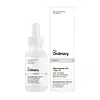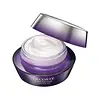What's inside
What's inside
 Key Ingredients
Key Ingredients

 Benefits
Benefits

 Concerns
Concerns

 Ingredients Side-by-side
Ingredients Side-by-side

Water
Skin ConditioningButylene Glycol
HumectantHydrogenated Polydecene
EmollientGlycerin
HumectantLimnanthes Alba Seed Oil
Skin ConditioningHydrogenated Lecithin
EmulsifyingDiphenylsiloxy Phenyl Trimethicone
Skin ConditioningCetearyl Alcohol
EmollientAdenosine
Skin ConditioningArginine
MaskingBetula Platyphylla Japonica Juice
Skin ConditioningCamellia Sinensis Leaf Extract
AntimicrobialDimethylsilanol Hyaluronate
HumectantGlycyrrhiza Glabra Leaf Extract
Skin ConditioningHydroxyproline
Skin ConditioningRhodomyrtus Tomentosa Fruit Extract
HumectantTocopherol
AntioxidantTremella Fuciformis Extract
HumectantVitis Vinifera Fruit Extract
Skin ConditioningBehenyl Alcohol
EmollientCarbomer
Emulsion StabilisingDimethicone
EmollientDisodium EDTA
Disodium Succinate
MaskingEctoin
Skin ConditioningHydrogenated Polyisobutene
EmollientLauryl Polyglyceryl-3 Polydimethylsiloxyethyl Dimethicone
Skin ConditioningPhytosterols
Skin ConditioningPhytosteryl Macadamiate
Skin ConditioningPhytosteryl Oleate
Skin ConditioningPhytosteryl/Behenyl/Octyldodecyl Lauroyl Glutamate
Skin ConditioningPolyglycerin-3
HumectantSodium Hydroxide
BufferingSodium Methyl Stearoyl Taurate
CleansingSuccinic Acid
BufferingXanthan Gum
EmulsifyingPhenoxyethanol
PreservativeParfum
MaskingHexyl Cinnamal
PerfumingLimonene
PerfumingLinalool
PerfumingWater, Butylene Glycol, Hydrogenated Polydecene, Glycerin, Limnanthes Alba Seed Oil, Hydrogenated Lecithin, Diphenylsiloxy Phenyl Trimethicone, Cetearyl Alcohol, Adenosine, Arginine, Betula Platyphylla Japonica Juice, Camellia Sinensis Leaf Extract, Dimethylsilanol Hyaluronate, Glycyrrhiza Glabra Leaf Extract, Hydroxyproline, Rhodomyrtus Tomentosa Fruit Extract, Tocopherol, Tremella Fuciformis Extract, Vitis Vinifera Fruit Extract, Behenyl Alcohol, Carbomer, Dimethicone, Disodium EDTA, Disodium Succinate, Ectoin, Hydrogenated Polyisobutene, Lauryl Polyglyceryl-3 Polydimethylsiloxyethyl Dimethicone, Phytosterols, Phytosteryl Macadamiate, Phytosteryl Oleate, Phytosteryl/Behenyl/Octyldodecyl Lauroyl Glutamate, Polyglycerin-3, Sodium Hydroxide, Sodium Methyl Stearoyl Taurate, Succinic Acid, Xanthan Gum, Phenoxyethanol, Parfum, Hexyl Cinnamal, Limonene, Linalool
 Reviews
Reviews

Ingredients Explained
These ingredients are found in both products.
Ingredients higher up in an ingredient list are typically present in a larger amount.
Phenoxyethanol is a preservative that has germicide, antimicrobial, and aromatic properties. Studies show that phenoxyethanol can prevent microbial growth. By itself, it has a scent that is similar to that of a rose.
It's often used in formulations along with Caprylyl Glycol to preserve the shelf life of products.
Water. It's the most common cosmetic ingredient of all. You'll usually see it at the top of ingredient lists, meaning that it makes up the largest part of the product.
So why is it so popular? Water most often acts as a solvent - this means that it helps dissolve other ingredients into the formulation.
You'll also recognize water as that liquid we all need to stay alive. If you see this, drink a glass of water. Stay hydrated!
Learn more about WaterXanthan gum is used as a stabilizer and thickener within cosmetic products. It helps give products a sticky, thick feeling - preventing them from being too runny.
On the technical side of things, xanthan gum is a polysaccharide - a combination consisting of multiple sugar molecules bonded together.
Xanthan gum is a pretty common and great ingredient. It is a natural, non-toxic, non-irritating ingredient that is also commonly used in food products.
Learn more about Xanthan Gum